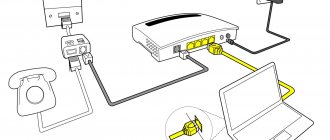Rostelecom is one of the largest Russian telecommunications companies. The provider provides wired local, long-distance and cellular communications, Internet and interactive television services throughout the country. For subscribers who decide to connect a home phone, Rostelecom offers several tariff plans designed to meet the needs of different categories of customers.
Let's look at the main advantages of installing a home phone from Rostelecom:
- The contract can be drawn up at the client’s home.
- Flexible tariff plans and the ability to change them.
- Possibility to choose your own number.
- 24/7 technical and information support.
- A variety of payment methods (terminals, banks, company and partner offices, electronic money, Russian Post).
- Many promotions carried out by the company for subscribers.
Submitting an application by phone
Rostelecom offers three ways to submit a request to connect to the home phone service using a call:
- by contacting the sales center;
- using an automatic system;
- by filling out the callback request form on the website.
The most convenient way to apply for a telephone connection is to call the hotline number 8-80010-00800. Calling this number is free from any mobile or landline phone. During the conversation, the sales center employee will need to inform the city of connection, and also inform that you want to install a Rostelecom home phone.
Another option to submit a request to connect your phone is to use the auto-informer, available at 8-80010-02525. After listening to the information, the system will offer to draw up an agreement automatically.
The company’s website also allows you to fill out an application on the page www.rt.ru/fastorder for a call back. It is enough to indicate your contact phone number, installation address and your name. After which, sales department specialists will contact you to confirm the order and clarify the necessary questions.
How much does it cost to activate the service?
Some people write on the Internet that the cost of connecting to the service is 10 thousand rubles. This is wrong. Of course, circumstances change over time in different regions. But in most cases, the provider does not require significant funds. Sometimes you only need to pay 1 ruble. It is better to check the latest information for a specific city on the official website.
The price may include the purchase of a telephone. Rostelecom sells the TX-214 model to TeXet. The device has the following features:
- large buttons with bright inscriptions (elderly people with poor eyesight will appreciate this);
- loud bell signal;
- quick dialing of numbers using one button (up to 13 such numbers are stored in memory).
Sending an application to connect a phone from the Rostelecom website
The company's portal also allows you to send a request to connect to the home telephone service. Just go to the website in the section dedicated to landline communications www.rt.ru/hometel/local, select the city of your residence. If necessary, here you can familiarize yourself with the tariffs available for the region, and then fill out an application. Upon receipt of the completed form, the company’s specialists will contact you by phone to clarify the details and time when specialists can perform the installation.
You can also activate the Rostelecom home phone service in the subscriber’s personal account. Before this you will have to register first. During this process, you will need to indicate your chosen login and password, as well as fill in your contact information. After processing the application in the sales department, employees will definitely call you back and arrange for a technician to come.
Installation methods
Telephone sockets can be installed in an open or closed manner. The open method means that all the decoration on the wall is preserved; the equipment is attached directly to the wallpaper or paint.
In this case, the wires are hidden in a cable channel located in the baseboard or on the wall. You can find cable channels of different colors and sizes, baseboards with a cable channel inside. Models with snap-on lids are convenient. There are also baseboards with built-in sockets. When buying them, choose those whose front panel fits well to the base, otherwise over time it will begin to lag.
Sometimes devices are mounted not on the wall, but on the floor. When connecting in an open way, they can even be glued with double-sided tape.
If the telephone socket is connected in a closed (hidden) way, the wires are laid in the channel before the socket is installed in the socket box. Sometimes the wires are laid in the wall and the socket is installed outside. Most often they use a copper single-core cable KPSV in a white polyethylene sheath or a copper single-pair cable TRP.
Most often, telephone sockets are not installed separately, but as part of an outlet block, for example, together with an electrical outlet and a switch, as in the photo.
Advice! To disguise the structure, place them behind furniture facades or behind monitors and TVs.
How to turn off your Rostelecom home phone?
For subscribers who want to disconnect their home phone for any reason, Rostelecom offers only two correct ways to cancel the service:
- Personal office visit. It is enough to contact any Rostelecom office and write a corresponding application. It should be borne in mind that this can take quite a lot of time, since the service specialists are quite busy.
- Send your application by mail. Must be sent by registered mail with return receipt requested. The text of the application must indicate passport details and place of registration, home telephone number and contract, as well as the date from which the provision of services should be terminated. It should be remembered that such a statement must be written in your own hand.
Before turning off your home telephone, it is highly advisable to seek advice from a technical support specialist or office manager. The fact is that in many small localities Internet and interactive television services are provided by Rostelecom on the basis of existing telephone lines. In this case, refusing your home phone may result in their inoperability.
In addition to giving up your home telephone, there is the possibility of temporarily suspending the service . This will not exempt you from paying for the line and maintaining the number, but it will help you avoid paying for the service itself, which will allow you to save quite a lot, for example, when going on a long vacation.
Basic Standards
With the development of technology, outdated sockets are replaced with new ones. More and more consumers are replacing RTShK-4 with a modern RJ-11 socket, the latter is considered universal.
Its connector is the same as that of other types, the difference lies in the number of wires running in the cable.
There are 5 standards for telephone sockets:
- RTShK-4. Now it is practically not used. Consists of a housing and 4 contacts. The fork has 4 plates made of metal. There is a plastic pin in the center that provides rigidity to the connection.
- RJ-11 and RJ-12. These connectors are the most common. Used to connect different types of phones. May have 2, 4, 6 contacts. Suitable for home use.
- RJ-14. The sockets are designed for installation in offices where you need to connect telephone-fax, modems for the Internet and similar devices. Sometimes the design has 4 contacts connected to four-wire wires. This makes it possible to use two different lines simultaneously.
- RJ-25. Similar to the previous species, it is found in office buildings. 6 connectors are used to connect local networks, modems, faxes and other necessary equipment.
- The last standard is called combined. The design of the socket is a combination of RTShK-4 and RJ-11.
Note! There is another standard not included in the list - RJ-45. Used to connect complex circuits in laptops, modems, etc.
Reviews of Rostelecom communications
I have been using a home phone from Rostelecom for many years. Lately the quality has improved significantly. It is obvious that the company is working on this. In addition, I got the Internet from them. Everything makes me happy too. The speed is on point. (Dmitriy).
I recently installed a home phone from Rostelecom, because without it there was no way to connect to the Internet. The connection quality is good, and they don’t notice any problems with it at all. The Internet also works like a clock. (Alexei)
I use all products from Rostelecom: cell phone, home phone, Internet and interactive television. It’s convenient that you can pay everything in one place at once. The quality of communication is quite good, but television and the Internet sometimes suffer due to the quality of the line. But in our village no one offers the best. In general, everything is quite at the level. (Nikolai).
Differences and advantages from cellular and landline communications
The main differences between IP telephony and landline telephony:
- There is no need to wait for a telephone line to be installed at home;
- No mandatory subscription fee;
- Ability to make video calls;
- Cheaper calls throughout Russia and the world;
- Free calls within the SIP provider network;
- Lack of geographical reference.
And indeed, when moving to a different address, you don’t need to change your phone number – you just need to connect the Internet to your apartment. Or you can even get by with a smartphone connected to the mobile Internet with a package tariff plan.
Differences between IP telephony and mobile communications:
- There is no need to go to a communication store and buy a SIM card;
- You can do without a telephone;
- Low prices for calls throughout Russia and around the world.
True, a mobile phone has one advantage - it can work in areas with a weak signal, where it is impossible to use the mobile Internet.
Telephone socket device
A telephone socket consists of several main elements:
- housings made of dielectric (non-conducting) material - ceramics or plastic,
- contacts - spring-loaded brass parts that are needed for reliable connection of conductive parts and uninterrupted flow of current,
- terminals - adapters for connecting cables.
The contact sockets of the device are recessed into the housing. This arrangement prevents accidental short circuits.
Telephone sockets can be single or multi-socket. Single-connector models allow you to connect one telephone set, multi-connector models allow you to connect several. The RJ 11 socket is a single-socket socket; it can be used to connect only one telephone.
RJ 11 connection
RJ 11 has two wires, so it’s easy to connect it yourself at home. To do this, you will need to connect the two ends of the wire with certain contacts in the socket, so that in the plug and in the socket they are located in a mirror image. For installation you need:
- two-core cables with a thickness of 0.3-0.5 mm,
- screwdrivers - flat or Phillips, depending on the type of screws, with an insulated handle,
- drill,
- insulation removal tool,
- tester,
- tool for crimping contacts - you can not use it, but crimp the contact plates with a screwdriver, but then the plug will not look so neat.
The video shows how to properly connect a telephone socket to the line.
Important! Work on connecting the socket should be carried out using rubber or latex gloves. The voltage in the low-current network reaches 60 V, dropping to 12 V when the tube is removed. If they try to call the phone, a voltage of 120 V will arise in the wires, that is, they may receive an electric shock. With such tension it is not dangerous, but unpleasant.
First of all, you need to turn off the electricity. Next, you need to remove the insulation from the wires. This is done with side cutters, pliers or a regular knife. You need to carefully remove the insulation from the wires so as not to damage the core of the telephone cable itself, otherwise it may break in the future.
Do not burn the insulation and then remove it with your fingers. You can burn yourself with hot plastic, and with this method it is difficult to remove the insulation carefully. You need to strip the wires at a distance of 4 cm from the end.
It is advisable to strip the wires generously: they are thin and fragile and can be easily damaged. The excess part, if any remains, can be easily hidden under the socket body. For closed installation, for convenience, the wires are made to protrude beyond the wall surface by 5-8 cm.
Next, use a tester to check the polarity of the wires. Typically, in telephone jacks, the red wire is positive and the green wire is negative. But it is better to check the polarity, since it is not known how the wires were located before. If it is not possible to use a tester, then connect the cables according to the diagram that comes with the device.
To check if the line is working, you need a voltmeter (multimeter). The line voltage should be 40-60 V.
After this, the wires are connected to the outlet according to the diagram. To do this, you will need a screwdriver - insert the wires into the connectors and tighten the screws, clamping them well.
If you need to install the outlet in a closed way, then first markings are applied to the wall showing where the device will be located. Then, using a puncher, holes are made according to the markings and the structure is secured with self-tapping screws. A protective casing is installed on top. At the end the device is also tested.
If you are installing a new point and there is no space for sockets on the wall, then first make a recess for them - a socket box. It is drilled out using a special crown attachment on a hammer drill with a diameter of 6-7 cm. Channels for laying wires are also drilled using a hammer drill. If there is no hammer drill, this can be done with a hammer and chisel. But such work is much longer and more labor-intensive.
After this, install the device in the socket box, making sure that the cables are not intertwined. Then the socket is secured using self-tapping screws and expansion screws. The gaps between the socket box and the wall are covered with gypsum mortar.
When the solution hardens, install the protective edging and front panel. The protective edging in modern models is attached with latches, and the front panel is fixed with screws.











